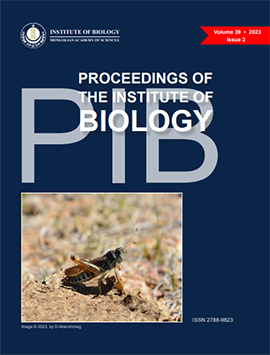Mammalian species richness and conservation status in the Numrug Strictly Protected Area
DOI:
https://doi.org/10.5564/pib.v39i2.3332Keywords:
Khingan mountain, mammals, diversity, habitats, conservationAbstract
The Numrug Strictly Protected Area (SPA) in eastern Mongolia serves as a unique ecological region, encompassing diverse landscapes from medium-low mountains to forests, meadows, and steppes. It was established in 1992, with subsequent expansion in 2019 to preserve the Khingan ecosystem and Manchuria's rich biodiversity. A total of 57 mammal species belonging to seven orders were identified in Numrug SPA, representing 39.3% of Mongolia's recorded mammal species after its expansion of 1.8 more in territory size and increases in habitats. Notably, 15 of these species hold regional and international endangered statuses, emphasizing the ecological significance of the area. The analysis reveals that river valleys and mountain steppes as key habitats to mammal diversity and warrants possible new species or registration in the species richness of Chiroptera and Rodentia in further.
Downloads
383
References
Ya Adiya, S, Dulamtseren, and G, Tsogtjargal, «In the "A" of Small Gobi Strictly Protected Area's mammalian species & conservation status», Proc. Inst. Biol., vol 28, pp 105–108, 2011.
A. Namkhai, Protected Areas of Mongolia, 3 ed. Ulaanbaatar, Mongolia: Bit press, 2022.
Y. Batchuluun, The physical geography of Mongolia, First. Ulaanbaatar, Mongolia, 2020.
S. Dulamtseren, «Dornod Mongolian (Dornod Sukhbaatar province) wild mammals», Ecosystem of Eastern Mongolia, vol 1, pp 18–27, 2001.
S. Dulamtseren and M. Munkhsaikhan, «Mammals of Onon, Ulz and Khalkh river basins in Mongolia», Forestry Institute, vol 2, pp 158–162, 1996.
D. Lchagvasuren, А. Stubbe, H. Ansorge, D. Dolch, and M. Stubbe, «Beitrag zur Säugetierfauna der Ostmongolei1», Erforsch. biol. Ress. Mongolei (Halle/Saale), vol 14, pp 71–94, 2021.
J. Ariunbold, M. Munkhbaatar, N. Nandin - Erdene, and D. Munkhnast, «Biology, Ecology and Conservation issues of Asian Particolored Bat (Vespertilio sinensis) in Eastern Mongolia», Proceedings of the Mongolian State University of Education, vol 3, pp 7–12, 2011.
G. Dovchindorj, «Distribution of the river otter (Lutra lutra linnaeus, 1758) in Numrug SPA», Ulaanbaatar, Mongolia, 2020.
G. Dovchindorj, Ecological aspects of wild camels in Mongolia. Ulaanbaatar, Mongolia, 2022.
G. Dovchindorj, «A brief report on the work at the Numrug SPA», Ulaanbaatar, Mongolia, 2023.
G. Dovchindorj, «Forest ungulates survey of Numrug SPA», Ulaanbaatar, Mongolia, 2018.
N. Batsaikhan, S. Shar, D. Lkhagvasuren, S. R. B. King, and R. Samiya, A field guide to the mammals of Mongolia, 3 ed. Ulaanbaatar, Mongolia, 2022.
S. Gombobaatar, S. Shar, U. Aibek, G. Gerelmaa, and S. Bayarkhuu, Biodiversity of Mongolia: A checklist of vertebrate and invertebrate animals, vol 1. Ulaanbaatar, Mongolia, 2019.
S. Dulamtseren, «Mongolian names of mammal taxonomy and systematics (Latin-Mongolian- English-Russian)», Proceedings of the State Nomenclatural Commission, vol 148, pp 3–72, 2003.
IUCN, «IUCN Red List of Threatened Species. Valid October 30, 2023, from https://www.iucnredlist.org.» 2023.
E. L. Clark et al., Mongolian Red List of Mammals, vol Regional Red List Series Vol. 1. Ulaanbaatar, 2006.
CITES, «Convention on International Trade in Endangered Species of Wild Fauna and Flora (CITES), Appendices I, II, and III». 2023.
T. Shiirevdamba, Mongolian Red Data Book. Ministry of Environment and Green Development. Ulaanbaatar: ADMON Printing, 2014.
E. Tuguldur, «Management Plan for Numrug SPA (2014-2018)», 2013.
J. Ariunbold, «Comprehensive studies of species composition, distribution and some biological issues of Mongolian Vesper Bats», Ph.D. Thesis, Mongolian National University of Education, 2018.
A. G. Bannikov, Mammals of the People’s Republic of Mongolia. Moscow, 1954.
V. E. Sokolov and V. N. Orlov, Identification Key to the Mammals of the Mongolian People’s Republic. Moscow: Nauka Press, 1980.
I. Horaček, «Status of Vesperus sinensis Peters, 1880 and remarks on the genus Vespertilio», Vespertilio, vol 2, pp 59–72, 1997.
Downloads
Published
How to Cite
License
Copyright (c) 2023 Ganbold Dovchindorj, Ganbold Dovchindorj

This work is licensed under a Creative Commons Attribution-NonCommercial 4.0 International License.
Copyright on any research article in the Proceedings of the Institute of Biology is retained by the author(s).
The authors grant the Proceedings of the Institute of Biology license to publish the article and identify itself as the original publisher.
![]()
Articles in the Proceedings of the Institute of Biology are Open Access articles published under a Creative Commons Attribution-NonCommercial 4.0 International License - CC BY NC.
This license permits use, distribution and reproduction in any medium, provided the original work is properly cited.




